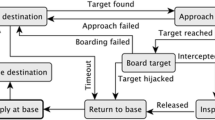Abstract
Peter T. Leeson’s The Invisible Hook provides an illuminating economic analysis of how pirates established governance structures regulating their organization. Leeson is successful in showing economic rationales for piratical institutions and adopts the view of the piratical enterprise as a for-profit business firm to further illustrate the point. This essay argues, however, that modern theories of the firm are not fully compatible with the nature of piratical organization. Rather, pirates seem to have suffered from problems much like those in traditional cooperatives, arising from organizing collective action and joint ownership of the means of production.
Similar content being viewed by others
Notes
Asset specificity is defined as “durable investments that are undertaken in support of particular transactions, the opportunity cost of which investments is much lower in best alternative uses or by alternative users should the original transaction be prematurely terminated” (Williamson 1985, p. 55).
Compare Hansmann’s statement on cooperative governance that it is common for them “to require that most members of the board of directors also be members of the cooperative” and “that all or nearly all of the cooperative’s directors not be hired managers” (Hansmann 1999, p. 397).
References
Alchian, A. A., & Demsetz, H. (1972). Production, information costs and economic organization. American Economic Review, 62(5), 777–795.
Burress, M. J., & Cook, M. L. (2009). A primer on collective entrepreneurship: A preliminary taxonomy. University of Missouri, Department of Agricultural Economics Working Papers. Columbia, Mo., University of Missouri, p 32.
Chaddad, F. R., & Cook, M. L. (2004). Understanding new cooperative models: An ownership-control rights typology. Review of Agricultural Economics, 26(3), 348–360.
Chiles, T. H., & McMackin, J. F. (1996). Integrating variable risk preferences, trust, and transaction cost economics. The Academy of Management Review, 21(1), 73–99.
Coase, R. H. (1937). The nature of the firm. Economica, 4(16), 386–405.
Cook, M. L., & Iliopoulos, C. (2000). Ill-defined property rights in collective action: The case of U.S. agricultural cooperatives. In C. Ménard (Ed.), Institutions, contracts and organizations (pp. 335–348). London: Edward Elgar Publishing.
Cook, M. L., & Plunkett, B. (2006). Collective entrepreneurship: An emerging phenomenon in producer-owned organizations. Journal of Agricultural and Applied Economics, 38(2), 421–428.
Grossman, S. J., & Hart, O. D. (1986). The costs and benefits of ownership: A theory of vertical and lateral integration. The Journal of Political Economy, 94(4), 691–719.
Hansmann, H. (1988). Ownership of the firm. Journal of Law, Economics, and Organization, 4(2), 267–304.
Hansmann, H. (1999). Cooperative firms in theory and practice. LTA, 48(4), 387–403.
Hansmann, H. (2000). The ownership of enterprise. Cambridge: MA, Harvard University Press.
Hart, O., & Moore, J. (1990). Property rights and the nature of the firm. Journal of political economy, 98(6), 1119–1158.
Hayek, F. A. (1937). Economics and knowledge. Economica, 4(13), 33–54.
Hayek, F. A. (1945). The use of knowledge in society. American Economic Review, 35(4), 519–530.
Hayek, F. A. (1978). Competition as a discovery process. New Studies in Philosophy, Politics, Economics, and the History of Ideas, pp 179–190.
Holmström, B., & Milgrom, P. (1994). The firm as an incentive system. The American Economic Review, 84(4), 972–991.
Klein, B., Crawford, R. A., et al. (1978). Vertical integration, appropriable rents, and the competitive contracting process. Journal of Law and Economics, 21(2), 297–326.
Leeson, P. T. (2007). An-arrgh-chy: the law and economics of pirate organization. Journal of Political Economy, 115(6), 1049–1094.
Leeson, P. T. (2009). Invisible Hook: The hidden economics of pirates. Princeton, NJ: Princeton University Press.
Olson, M. (1971). The logic of collective action: Public goods and the theory of groups. Cambridge: MA, Harvard University Press.
Prendergast, C. (1999). The provision of incentives in firms. Journal of Economic Literature, 37(1), 7–63.
Pringle, P. (1953). Jolly Roger: The story of the great age of piracy. New York: Norton.
Simon, H. A. (1957a). Administrative behavior: A study of decision-making processes in administrative organization. New York: MacMillan Company.
Simon, H. A. (1957b). Models of man: Social and rational. New York: John Wiley & Sons.
Simon, H. A. (1957c). A formal theory of the employment relation. In H. A. Simon (Ed.), Models of man (pp. 183–195). New York: John Wiley & Sons.
Williamson, O. E. (1979). Transaction-cost economics: The governance of contractual relations. The Journal of Law and Economics, 22(2), 3–61.
Williamson, O. E. (1985). The economic institutions of capitalism. New York: Free Press.
Williamson, O. E. (1991). Comparative economic organization: the analysis of discrete structural alternatives. Administrative Science Quarterly, 36(2), 269–296.
Williamson, O. E. (1996). The mechanisms of governance. Oxford University Press.
Williamson, O. E., Wachter, M. L., et al. (1975). Understanding the employment relation: the analysis of idiosyncratic exchange. The Bell Journal of Economics, 6(1), 250–278.
Author information
Authors and Affiliations
Corresponding author
Rights and permissions
About this article
Cite this article
Bylund, P.L. Piracy, Inc.—on the bearing of the firm analogy to pirate organization. Rev Austrian Econ 23, 299–305 (2010). https://doi.org/10.1007/s11138-010-0106-4
Published:
Issue Date:
DOI: https://doi.org/10.1007/s11138-010-0106-4




